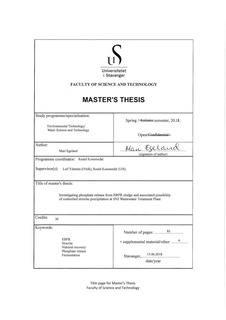| dc.contributor.advisor | Ydstebø, Leif | |
| dc.contributor.advisor | Kommedal, Roald | |
| dc.contributor.author | Egeland, Mari | |
| dc.date.accessioned | 2018-10-16T11:36:32Z | |
| dc.date.available | 2018-10-16T11:36:32Z | |
| dc.date.issued | 2018-06 | |
| dc.identifier.uri | http://hdl.handle.net/11250/2568242 | |
| dc.description | Master's thesis in Environmental Technology | nb_NO |
| dc.description.abstract | The main treatment stage at SNJ Wastewater Treatment Plant was recently upgraded from chemical treatment to mechanical-biological treatment with Enhanced Biological Phosphorous Removal (EBPR). The implementation of EBPR leads to higher levels of free phosphate within the reject streams from sludge thickening and dewatering, increasing the risk of operational problems due to uncontrolled struvite (MgNH4PO4•6H2O) precipitation. However, controlled struvite precipitation provides a way of mitigating these problems as well as a possibility for nutrient recovery. The primary aim of this project was to investigate the phosphate release from the EBPR sludge at SNJ with respect to the possibility of controlled struvite precipitation associated with the waste sludge thickening process. The potential of struvite precipitation in the reject stream from the sludge thickener depends on the amount of phosphate released from the sludge during storage. Batch tests were performed to assess the endogenous and stimulated phosphate release from the EBPR sludge, with addition of VFA-rich filtrate from fermented primary sludge to stimulate excess release. In addition, sampling in the treatment plant was conducted to investigate the EBPR performance and phosphate flow through the bioreactor. The average endogenous and stimulated phosphate release rates in the batch tests were 1.22 g P/kg TSS d-1 and 2.90 g P/kg TSS d-1 respectively. The stimulated release rate and the overall phosphate release during the tests were lower than expected due to low poly-P reserves within the EBPR sludge. Sampling in the treatment plant revealed low EBPR activity due to oxygen entrainment in the anaerobic zone of the bioreactor, and significant secondary phosphate release in the secondary settler. The consequence of these observations is less phosphate available for controlled struvite precipitation, thus lower phosphorous recovery. Based on the stimulated release rate, the theoretical struvite yield from the sludge thickener reject stream was 13.7 kg/d, while the struvite precipitation potential calculated from the phosphate load on the bioreactors was 474 kg struvite/d. The discrepancy was attributed to the low EBPR activity in the treatment plant. If phosphate is to be recovered as struvite at SNJ, the EBPR process needs to be optimized, and the operational problems associated with oxygen entrainment and secondary release must be mitigated. | nb_NO |
| dc.language.iso | eng | nb_NO |
| dc.publisher | University of Stavanger, Norway | nb_NO |
| dc.relation.ispartofseries | Masteroppgave/UIS-TN-IKBM/2018; | |
| dc.rights | Navngivelse 4.0 Internasjonal | * |
| dc.rights.uri | http://creativecommons.org/licenses/by/4.0/deed.no | * |
| dc.subject | teknisk miljøvern | nb_NO |
| dc.subject | vann | nb_NO |
| dc.subject | environmental technology | nb_NO |
| dc.subject | water science and technology | nb_NO |
| dc.subject | struvite | nb_NO |
| dc.subject | nutrient recovery | nb_NO |
| dc.subject | phosphate release | nb_NO |
| dc.subject | fermentation | nb_NO |
| dc.title | Investigating phosphate release from EBPR sludge and associated possibility of controlled struvite precipitation at SNJ wastewater treatment plant | nb_NO |
| dc.type | Master thesis | nb_NO |
| dc.subject.nsi | VDP::Teknologi: 500::Miljøteknologi: 610 | nb_NO |

